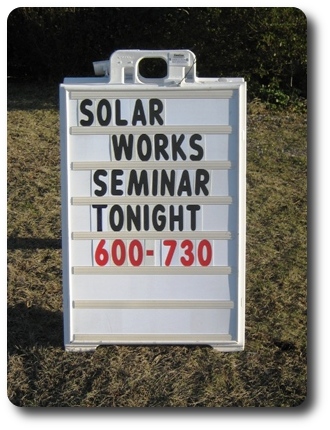
Last evening I attended a seminar on residential solar systems presented by Alteris Renewables, a firm that specializes in integration and installation of renewable energy systems. This particular talk was focused on photovoltaic solar systems and the associated Connecticut state assistance program.
The earth receives huge amounts of energy every year in the form of sunlight. Photovoltaic solar systems are able to capture some of that energy and convert it directly into electricity. Homeowners can deploy systems that connect to the power grid, so that during sunny times they deliver power to the utility companies, and during non-sunny times they draw power from the grid. Photovoltaic technology has advanced to the point where a homeowner is able to generate enough power (on an average basis over the year) to offset all of their electricity usage.
One of the negatives of alternative energy is the substantial up-front investment. If an individual were to install a photovoltaic system sufficient to generate 100% of their electricity needs, then the base price for the equipment and installation would be well into five figures. One large system that was used as an example in the presentation cost over $70,000. Which is more than most of us have laying around these days.
To encourage investment in systems like these, Connecticut has put a program in place to help homeowners overcome the initial cost. CT Solar Lease is a program that combines rebates from the Connecticut Clean Energy Fund and leases from CT Solar Leasing, LLC to install systems with no down payments for the homeowner. Instead homeowners commit to a 15 year lease with fixed payments. In theory the payments will initially be comparable to their monthly power bill and will stay constant as the price of electricity increases over time. After the 15 years the homeowner has the option to extend the lease for 5 years at a considerably lower rate, buy the system at its current market value, or pay the un-installation expenses.
When buying through the CT Solar Lease program, the homeowner that installed the $70,000+ system mentioned above did not pay anything for installation and set-up. The rebate from the state covered over half of the cost and the lease made up the difference. He has monthly payments of about $160 for 15 years and then projected monthly payments of about $35 per month if he chooses to extend the lease through year 20. He has effectively locked in his power costs for the life of the lease. Beyond that, he will have the opportunity to buy a power-generating asset for an undetermined one-time cost and then receive the electricity for free for the remainder of the system’s useful life (estimated to be 35 years). If electricity prices continue to increase on an annual basis, then he will save himself a considerable amount of money over time.
With the financial burden of solar substantially reduced, the next major challenge is identifying an appropriate site. Photovoltaic cells are ideally positioned facing south and never in the shade. However the reality is that there are very few perfect sites, so this is where the professionals from Alteris enter the picture. They have experience siting and installing photovoltaic systems and are willing to do initial site and financial analysis for free.
Some other interesting tidbits about solar:
1. Connecticut’s environment is not dramatically worse than Arizona’s for generating solar power - we have more cloudy days, but the systems are more efficient in our cooler climate.
2. CT state law prohibits solar improvements from increasing a property’s assessed value, and therefore taxes.
3. A 2007 report in the Appraisal Journal of the National Appraiser’s Association found that home values increase by $20 for every $1 in energy savings, which suggests that investments in solar systems would have a 95% payback based on current technologies and costs.
4. If you generate more power than you use in a year, then CL+P will cut you a check.
5. Photovoltaic systems connected to the grid must turn off (for safety reasons) if the grid goes down - they are not a backup power source for power outages.
If you are serious about investigating solar, send me an email and I would be happy to pass on the local expert’s contact information (didn’t have a chance to ask for his permission to post it).

